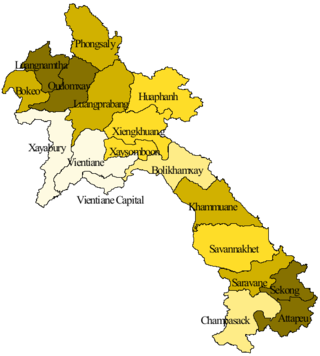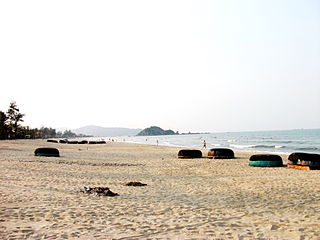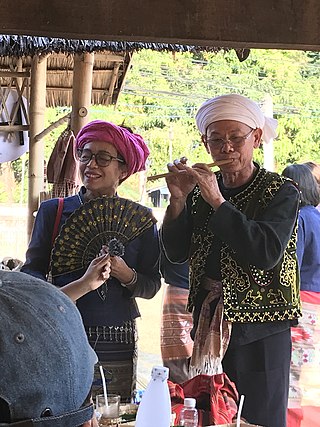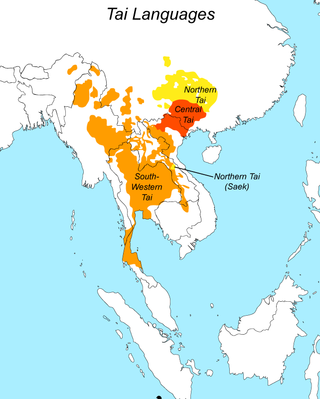Thoulakhom district | |
|---|---|
 Location of Thoulakhom district in Laos | |
| Country | Laos |
| Province | Vientiane |
| Time zone | UTC+7 (ICT) |
Thoulakhom is a district of Vientiane province, Laos. [1] [2]
Thoulakhom district | |
|---|---|
 Location of Thoulakhom district in Laos | |
| Country | Laos |
| Province | Vientiane |
| Time zone | UTC+7 (ICT) |
Thoulakhom is a district of Vientiane province, Laos. [1] [2]

Laos, officially the Lao People's Democratic Republic, is a landlocked country in Southeast Asia. At the heart of the Indochinese Peninsula, Laos is bordered by Myanmar and China to the northwest, Vietnam to the east, Cambodia to the southeast, and Thailand to the west and southwest. Its capital and largest city is Vientiane.

Kaysone Phomvihane was the first leader of the Communist Lao People's Revolutionary Party from 1955 until his death in 1992. After the Communists seized power in the wake of the Laotian Civil War, he was the de facto leader of Laos from 1975 until his death. He served as the first Prime Minister of the Lao People's Democratic Republic from 1975 to 1991 and then as the second President from 1991 to 1992.

Laos, officially the Lao People's Democratic Republic, is divided into 17 provinces and one prefecture, the Vientiane capital city municipality. The special administrative zone, Xaisomboun, created in 1994, was dissolved on 13 January 2006. In 2013, parts of the former special administrative zone was reestablished as Xaisomboun province.
Saek is a Tai language spoken in at least ten villages in Khammouane Province, Laos, and at least four villages in Nakhon Phanom Province in northeastern Thailand, just across the Mekong River. It is spoken by the Saek people.
Laos is divided into 17 provinces (khoueng) and one prefecture which includes the capital city Vientiane . Provinces are further divided into districts (muang) and then villages (ban). An 'urban' village is essentially a town.

Wattay International Airport is one of the few international airports in Laos and the country's main international gateway, serving the capital Vientiane, located 3 km (2 mi) outside of the city centre. A larger domestic terminal was constructed in 2018 and connected to the international terminal. There is a Lao Air Force installation at one end of the airport.
Phu Thai is a Southwestern Tai language spoken in Laos and Thailand. Although it appears different from the Isan and the Lao languages, it is spoken in areas where these languages are predominant and has been influenced by them. Comparisons of Phu Thai with other Tai languages such as Tay Khang have not yet been done systematically enough to yield convincing results.
Another aspect of Phu Thai is its contact with the Katuic languages, a branch of the Austroasiatic languages. Whether in the Phu Thai areas of Central Laos or in more recent locations of Northeastern Thailand, one can find, along with Phu Thai, a few Katuic dialects known locally as Bru, So or Katang. James R. Chamberlain (2012) focusing on anthropological issues describes “the Phou Thay – Brou relationship” as a “symbiosis” and states that “the Phou Thay – Brou relationship has never evolved into a feudal system”.

Nghệ An is a coastal province near the northernmost part of the North Central Coast region, the Central of Vietnam. It borders Thanh Hóa to the north, Hà Tĩnh to the south, Xiangkhouang, Bolikhamsai and Houaphan of Laos to the west, and the East Sea to the east.
Laos is divided into 17 provinces and 1 prefecture, or capital city municipality. Furthermore, 1 so-called special administrative zone existed between 1994 and 2006, when it was re-merged into its surrounding provinces. The Xaisomboun special administrative zone was later recreated as the 17th province. Each province is subdivided into districts and then subdivided into villages.

The Tai Lü people are an ethnic group of China, Laos, Thailand, Burma and Vietnam. They speak a Southwestern Tai language.

The following outline is provided as an overview of and topical guide to Laos:

North Vietnam supported the Pathet Lao to fight against the Kingdom of Laos between 1958–1959. Control over Laos allowed for the eventual construction of the Ho Chi Minh Trail that would serve as the main supply route for enhanced NLF and NVA activities in the Republic of Vietnam. As such, the support for Pathet Lao to fight against Kingdom of Laos by North Vietnam would prove decisive in the eventual communist victory over South Vietnam in 1975 as the South Vietnamese and American forces could have prevented any NVA and NLF deployment and resupply if these only happened over the 17th Parallel, also known as the Demilitarized Zone (DMZ), a narrow strip of land between North and South Vietnam that was closely guarded by both sides. It also helped the Pathet Lao win against the Kingdom of Laos, even though the Kingdom of Laos had American support.

Vientiane is the capital and largest city of Laos. Comprising the five urban districts of Vientiane Prefecture, the city is located on the banks of the Mekong, right at the border with Thailand. Vientiane was the administrative capital during French rule and, due to economic growth in recent times, is now the economic center of Laos. The city had a population of 1,001,477 as of the 2023 Census.

Tai peoples are the populations who speak the Tai languages. There are a total of about 93 million people of Tai ancestry worldwide, with the largest ethnic groups being Dai, Thais, Isan, Tai Yai (Shan), Lao, Tai Ahom, and Northern Thai peoples.
Phanaʼ ; also called Bana or Pana) is a Loloish language of Laos and China. Phanaʼ is spoken by 500 people in Laos. In China, it is spoken in Mengla County, Yunnan Province. It is closely related to Sila, which is spoken by 2,000 people in Laos and Vietnam. Badenoch reports that it is similar to.

Savannakhet is a province of Laos. The name derives from Savanh Nakhone the province's original name. It bears the same meaning as Nakhon Sawan, a city in Thailand.

Saiyabuli province is a province in northwest Laos. Saiyabuli town is the capital of the province. Saiyabuli is the only Lao province that is completely west of the Mekong River.
The Yang people, also known as the Nhang or Nyang, are a Tai-speaking ethnic group of Phongsaly Province, northwestern Laos. Chazee (1998) reports that they number 5,843 people as of 2015. The Yang are heavily influenced by Tai Lue culture, although the Yang of Namo Nua village, Oudomxay province are more heavily influenced by Tai Dam people culture.